中职英语购物教学设计
- 格式:doc
- 大小:68.62 KB
- 文档页数:8
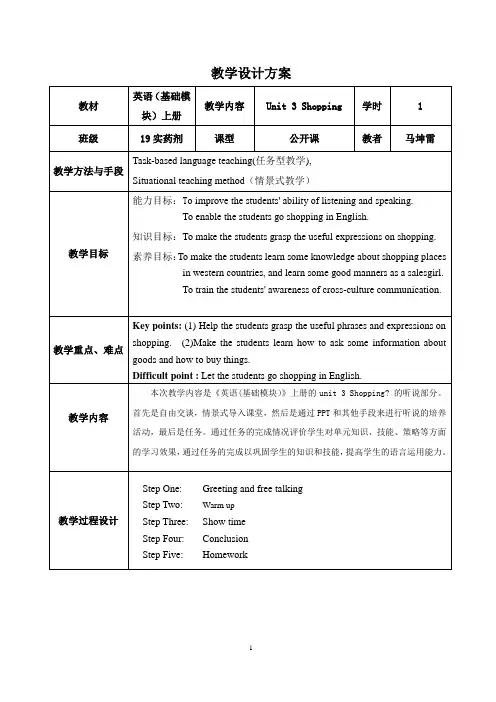
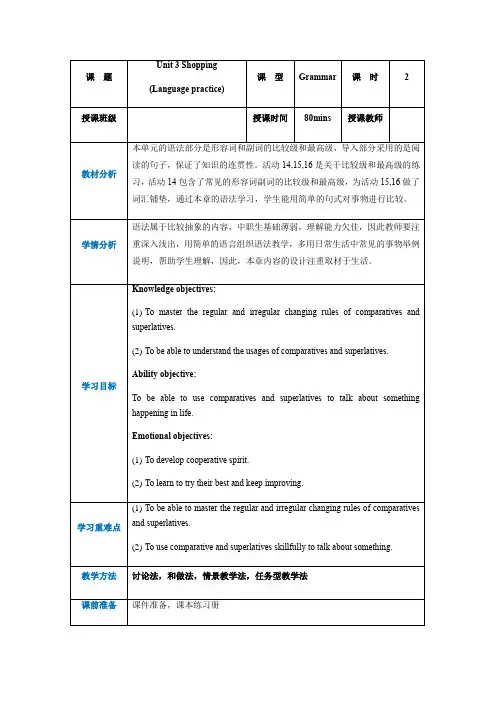

![中职英语Book2unit6教案[1]](https://uimg.taocdn.com/cbf459e5856a561252d36fe5.webp)
Unit6 lesson3 The supermarket教案一、教学内容分析本单元的中心话题是“shopping”.“购物”的话题不是第一次出现。
在初中每一年级都涉及过此项内容。
本单元所涉及到的知识,其中许多句型是以前见过,并练习使用过的,现在学习本单元的话题Shopping,学生会感到很亲切,也很简单,并会有新的体会。
第3课The supermarket,虽然话题是超市,但是,内容反映的是如何精明购物,有一定难度。
通过Task1 Match 要学生知道日常生活中的一些购物场所和购物方式。
学生讨论说出在超市经常购买的一些商品。
Task3 Read and match,通过学生阅读Smart Supermarket Shopping短文,基本了解超市这一购物场所及其有关情况,使学生对购物有进一步的了解。
通过阅读了解超市购物的一些购物建议,知道如何成为一名精明购物者。
Task4 要求学生再读课文,用文中动词的适当形式填空,目的是引出动词不定式的一些用法,初步感受动词不定式在句子中的应用,在Task5中,重点归纳动词不定式的一些用法。
Task6对话练习,目的是通过对话的形式继续巩固学生对精明购物的理解和运用。
二、教学目标和要求1、语言知识目标 (Knowledge objectives)1)、掌握、理解、运用以下有关购物词汇:supermarket,department store,chain store, smart supermarket shopping, spend on,grocery, check out ,tip, off-peak time,save your time,make a list,avoid doing,make some decisions2)、语法:识别动词不定式的结构并总结它在本单元的用法。
3)、话题:Talk about Smart Supermarket Shopping.2、能力目标:(Ability objectives)1)基本了解超市这一购物场所及其有关情况,使学生对购物有进一步的了解。
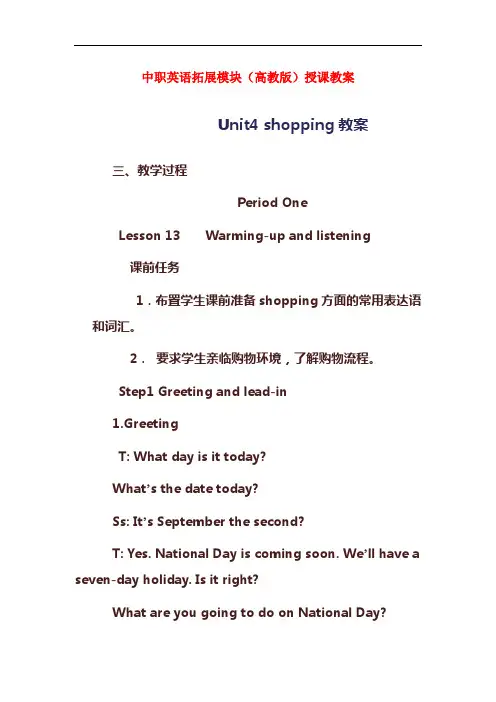
中职英语拓展模块(高教版)授课教案Unit4 shopping教案三、教学过程Period OneLesson 13 Warming-up and listening课前任务1.布置学生课前准备shopping方面的常用表达语和词汇。
2.要求学生亲临购物环境,了解购物流程。
Step1 Greeting and lead-in1.GreetingT: What day is it today?What’s the date today?Ss: It’s September the second?T: Yes. National Day is coming soon. We’ll have a seven-day holiday. Is it right?What are you going to do on National Day?Ss: Travel \ visit friends\stay at home\shopping.T: Shopping, good idea. I’m going shopping too on National Day. Would you like to go with me.? I’ll wait for you.2.Lead inT :Look at the screen. Where are they? What are they doing?Ss: They are at the supermarket. They are shopping.T: Today we’ll have a new unit. Unit 4. Lesson 13 Shopping.(板书)Step2.Brainstorm ( class work)1,T: When talking about shopping, what do you think of?Ss: money goods shopT: (Lead the students to think of as many words as possible .)When we go shopping , what must we take with us?Where can we go shopping?What can we buy?What makes you decide to buy the thing you want at last.? ( the style, the Price.)If it is too expensive, what will you do ? . If it is a little more expensive what will you do ? .2.After the brainstorming show the following words through the computer,and learn the new words in red.Step3 Listen and choose the words youhear.(Page40)T: We’ve learnt so many words. Now let’s see if you have remembered them.Listen to the words twice and then tick the words you hear..Step4 Reading the following signsread the signs correctlyT: We can go to shops , stores , markets or supermarkets to buy things. If I want to buy many different things at a place, Where shall I go ?Ss: supermarket.T: Would you please tell me some supermarkets in Wenzhou\Shangtang---?Ss: 好又多,山姆士---T: Great, but they are all too large. How can I find what I want in such large markets. Just go here and there? Are there any signs I can follow?T: Signs can tell us a lot. If we can read the signs correctly in our life. It can help us a lot. Are you good at reading signs? Here are some signs for you to read.shoe shop stationerycashieron sale on sale bargain discountT: Discuss the following signs and pictures with your partner and then I will ask some of you to tell me what you know from the sign.What can we buy here? (shoe shop)What about the second one? (writing materials are sold here)Now the third one. If we have bought something , what must we do here? (pay money) The fourth one? What’s the meaning of the sign? (The things are cheaper than before)The fifth one ? It also means things are on sale. How much is it cheaper than it is before?The six one? Can you guess? What is the shop owner and the customer doing? (bargain, the customer is asking for the lower price)Read the new words again.Step5 listen and choose the right sentencePre-listeningT: suppose you are at the shoe shop. I am the shop owner and you are a custom. Can you make a small dialogue with me .2.The following are some dialogues between the shop assistant and the customer. Listen and choose the sentence you hear. (Page40-41)First go through all the sentences.Listen for the first time and choose the sentences.Listen for the second and check what they have chosen.Check the answers in pairs.Post-listening (pair work)2) Show some useful expressions between shop assistants and customers. Let them choose one item to make dialogues in pairs. Act out their in front of the class.Useful expressions between shop assistants and customers:AssistantsCan I help you?What can I do for you?Looking for something special ?Which one would you like?We won’t sell it at any price .You are short one dollar.customersI am looking for ---I’ve had my eye on ---for a long time.I just do window shopping.Not really,just looking around if you don’t mind. How much is it?How much does it cost?How expensive is it?How much do I owe you.?.I don’t have any more at hand.Here you go. Keep the change.。
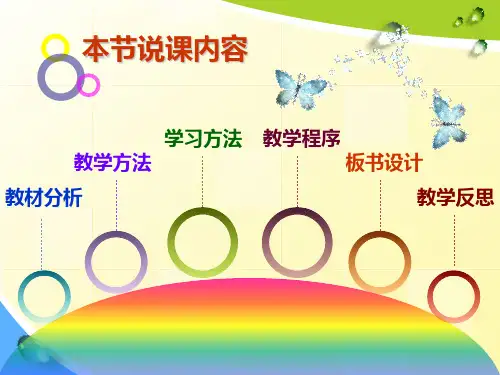

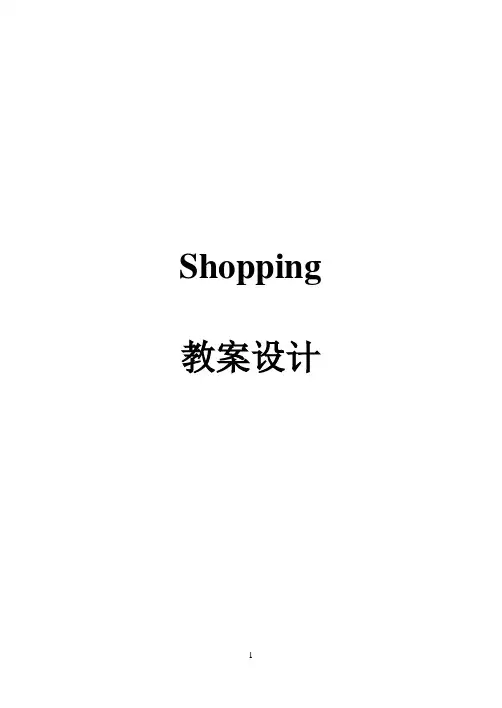
Shopping 教案设计Unit2 shopping教案一、教学内容分析本单元的中心话题是“shopping”.“ 购物”的话题不是第一次出现。
在初中每一年级都涉及过此项内容。
本单元所涉及到的知识,其中许多句型是以前见过,并练习使用过的,现再学习本单元的话题Shopping,学生会感到很亲切,并会有新的体会。
第13课导入目的,通过warming-up和听力练习让学生初步了解商品名称和谈论购物时常用的词汇和表达方式,熟悉超市里的购物环境,并学习八个辅音音标的发音方法。
第14课通过阅读课文了解超市这一购物场所及其有关情况,使学生对购物有进一步的了解。
第15课通过情景对话及其练习掌握购物时的情景英语。
第16课侧重于培养学生的写作能力,要求学生能正确使用介词及连词的用法。
二、教学目标和要求1、语言知识目标(Knowledge objectives)1)、掌握、理解、运用以下有关购物词汇:bargain, cashier, stationary, discount, store, shop, assistant, priceless, medium, cash, necklace, special, owe, supermarket, product, department, customer,probably, dairy, pleasing, serve, gift, wallet, design, shelf, trap, respect, companion, process, fortune, opposite, apparently, original, attentively, local, overcharge, on sale, wait on, short one dollar, at hand , the amount of , instead of , price tag, that much, gold ring, look around, excellent choice, slow down, contrary to , in all ,m by chance, just about2)、语法:复习并掌握介词和连词的用法。
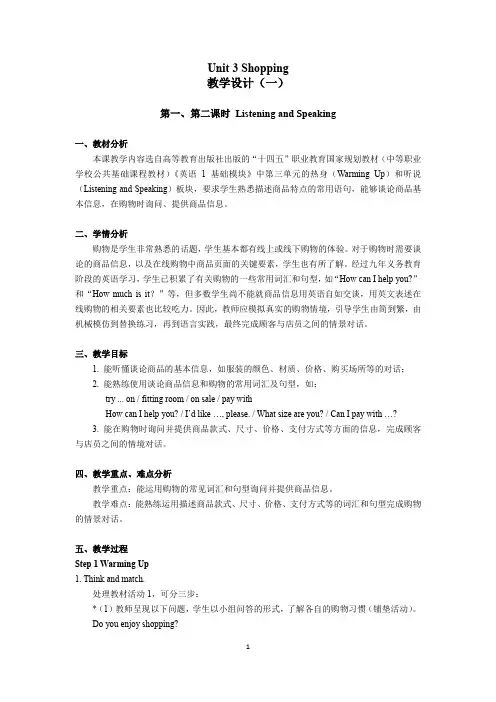
Unit 3 Shopping教学设计(一)第一、第二课时Listening and Speaking一、教材分析本课教学内容选自高等教育出版社出版的“十四五”职业教育国家规划教材(中等职业学校公共基础课程教材)《英语 1 基础模块》中第三单元的热身(Warming Up)和听说(Listening and Speaking)板块,要求学生熟悉描述商品特点的常用语句,能够谈论商品基本信息,在购物时询问、提供商品信息。
二、学情分析购物是学生非常熟悉的话题,学生基本都有线上或线下购物的体验。
对于购物时需要谈论的商品信息,以及在线购物中商品页面的关键要素,学生也有所了解。
经过九年义务教育阶段的英语学习,学生已积累了有关购物的一些常用词汇和句型,如“How can I help you?”和“How much is it?”等,但多数学生尚不能就商品信息用英语自如交谈,用英文表述在线购物的相关要素也比较吃力。
因此,教师应模拟真实的购物情境,引导学生由简到繁,由机械模仿到替换练习,再到语言实践,最终完成顾客与店员之间的情景对话。
三、教学目标1. 能听懂谈论商品的基本信息,如服装的颜色、材质、价格、购买场所等的对话;2. 能熟练使用谈论商品信息和购物的常用词汇及句型,如:try ... on / fitting room / on sale / pay withHow can I help you? / I’d like …, please. / What size are you? / Can I pay with …?3. 能在购物时询问并提供商品款式、尺寸、价格、支付方式等方面的信息,完成顾客与店员之间的情境对话。
四、教学重点、难点分析教学重点:能运用购物的常见词汇和句型询问并提供商品信息。
教学难点:能熟练运用描述商品款式、尺寸、价格、支付方式等的词汇和句型完成购物的情景对话。
五、教学过程Step 1 Warming Up1. Think and match.处理教材活动1,可分三步:*(1)教师呈现以下问题,学生以小组问答的形式,了解各自的购物习惯(铺垫活动)。
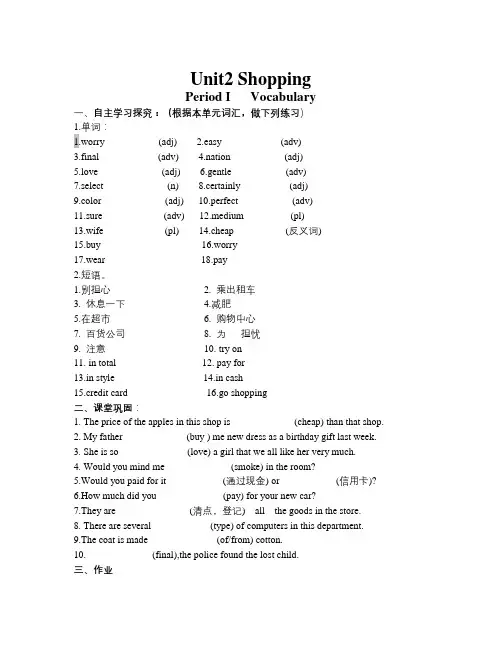
Unit2 ShoppingPeriod I Vocabulary一、自主学习探究:(根据本单元词汇,做下列练习)1.单词:1.worry___________(adj)2.easy____________(adv)3.final____________(adv)4.nation___________(adj)5.love_____________(adj)6.gentle___________(adv)7.select_____________(n) 8.certainly__________(adj)9.color_____________(adj) 10.perfect __________ (adv)11.sure ____________(adv) 12.medium _________(pl)13.wife ____________(pl) 14.cheap __________(反义词)15.buy_______ ________ 16.worry________ ________17.wear________ _______ 18.pay________ ________2.短语。
1.别担心_______________2. 乘出租车____________3. 休息一下_____________4.减肥________________5.在超市________________6. 购物中心____________7. 百货公司_____________ 8. 为担忧___________9. 注意_______________ 10. try on_______________11. in total ______________ 12. pay for______________13.in style______________ 14.in cash_______________15.credit card____________ 16.go shopping__________二、课堂巩固:1. The price of the apples in this shop is ____________ (cheap) than that shop.2. My father ____________ (buy ) me new dress as a birthday gift last week.3. She is so _____________ (love) a girl that we all like her very much.4. Would you mind me_____________ (smoke) in the room?5.Would you paid for it ___________(通过现金) or ___________(信用卡)?6.How much did you_____________ (pay) for your new car?7.They are_______________(清点,登记) all the goods in the store.8. There are several ___________ (type) of computers in this department.9.The coat is made______________(of/from) cotton.10._____________ (final),the police found the lost child.三、作业肯定式:否定式:在句中可以作______________________________________等成分。
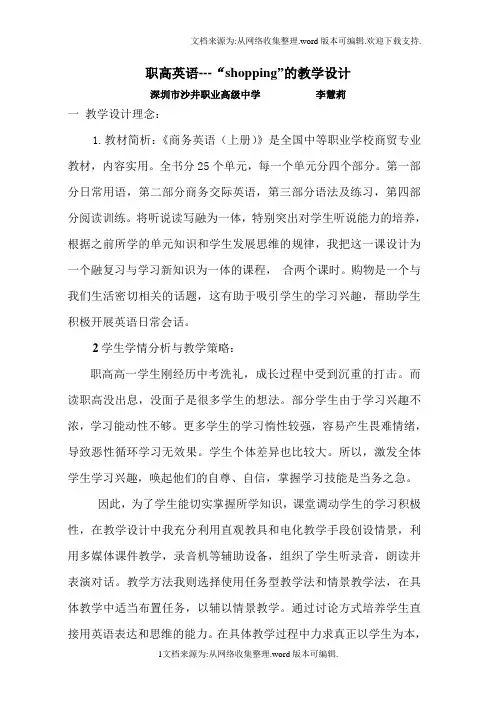
职高英语---“shopping”的教学设计深圳市沙井职业高级中学李慧莉一教学设计理念:1.教材简析:《商务英语(上册)》是全国中等职业学校商贸专业教材,内容实用。
全书分25个单元,每一个单元分四个部分。
第一部分日常用语,第二部分商务交际英语,第三部分语法及练习,第四部分阅读训练。
将听说读写融为一体,特别突出对学生听说能力的培养,根据之前所学的单元知识和学生发展思维的规律,我把这一课设计为一个融复习与学习新知识为一体的课程,合两个课时。
购物是一个与我们生活密切相关的话题,这有助于吸引学生的学习兴趣,帮助学生积极开展英语日常会话。
2学生学情分析与教学策略:职高高一学生刚经历中考洗礼,成长过程中受到沉重的打击。
而读职高没出息,没面子是很多学生的想法。
部分学生由于学习兴趣不浓,学习能动性不够。
更多学生的学习惰性较强,容易产生畏难情绪,导致恶性循环学习无效果。
学生个体差异也比较大。
所以,激发全体学生学习兴趣,唤起他们的自尊、自信,掌握学习技能是当务之急。
因此,为了学生能切实掌握所学知识,课堂调动学生的学习积极性,在教学设计中我充分利用直观教具和电化教学手段创设情景,利用多媒体课件教学,录音机等辅助设备,组织了学生听录音,朗读并表演对话。
教学方法我则选择使用任务型教学法和情景教学法,在具体教学中适当布置任务,以辅以情景教学。
通过讨论方式培养学生直接用英语表达和思维的能力。
在具体教学过程中力求真正以学生为本,将课堂还原为学生的课堂、师生共同拥有的精神畅游的场所。
3 在研究教材的前提下,确定本课的教学目标如下:(1) 知识目标,使学生掌握多种常见商品的单词。
其次,学生要学会如何和用句型描述产品特色。
(2)技能目标:通过听力与朗读提高学生听说能力;通过学习购物常用句型发展学生英语交际口语技能。
(3)情感目标:引导学生热爱生活,享受与他人交往沟通的乐趣;通过完成练习,增强学生学习语言的自信心。
(4)学习策略目标。
中专英语Let’s do some shopping教学设计一、学情分析笔者授课的班级是我校一年级金融事务专业,学生们聪明、活泼,但是缺少对英语学习的兴趣和热情,特别是当他们用英语交流的时候。
因此教师应采取适当的课堂教学活动来激发他们的学习兴趣,吸引他们的注意力。
授之以鱼不如授之以渔,教师有必要想方设法培养学生自主学习的能力。
二、教材分析1.本课的地位及作用本节课是第五单元第一课时,包括热身活动、听力以及对话练习。
通过本节课的学习,学生们能提高自身的听说能力,同时,购物这个话题与他们的生活甚至是未来的职业都密切相关。
众所周知,购物是旅游业和商业的重要组成部分,因此当学生们意识到其重要性时他们的学习积极性也就被调动起来了。
那么如何自如的运用购物用语并简单介绍商品信息就成为本节课的最终目标。
2.教学重点学生们能理解购物的全过程,并能运用相关词汇、短语和句子为顾客提供专业的服务。
3.教学难点学生们能恰当处理退货和换货的问题,并注意服务过程中的技巧和态度。
三、教学目标1.知识目标学生们能识别并运用购物词汇和表达。
2.能力目标Level A:理解基本的购物用语,如:Can I help you?How much is it?Can you give me a discount?I’m looking for … All women’s wear is on sale today,25% off.Level B:能比较熟练地运用关键词和表达进行对话练习。
Level C:能根据所给的情境恰当的为顾客服务(注意服务态度)。
3.情感目标A学生们将会认识到工作中合作的重要性;B.学生们对“顾客就是上帝”有更深入的理解并提供微笑服务。
4.教学方法和手段教法:听说法、情境教学法以及任务驱动法。
学法:自主学习法、合作学习法以及探究学习法。
手段:多媒体课件和动画视频。
四、教学过程1.Lead-in师生互致问候,随后教师播放视频:在商场工作的小李遇到了麻烦,一位美国游客想购买一些纪念品,但是小李不知如何用英语表达。
《Shopping Reading and Writing》教学设计方案(第一课时)一、教学目标1. 学生能够理解并识别购物相关的英文词汇,如商品、价格、支付方式等。
2. 学生能够使用简单的英语句式描述购物需求和购物过程。
3. 学生能够用英语进行简单的购物交流,如询价、报价、支付等。
4. 培养学生的英语口语表达能力和团队协作精神。
二、教学重难点1. 重点:掌握购物相关的英文词汇和表达方式,能够进行简单的购物交流。
2. 难点:在实际情境中运用英语进行购物交流,提高口语表达的流利度和准确性。
三、教学准备1. 准备购物相关的英文词汇卡片和实物商品。
2. 准备一些简单的购物场景视频或图片。
3. 准备一些简单的支付和配送模拟工具。
4. 提前与学生沟通了解他们的英语水平和学习习惯,以便设计适合他们的教学方案。
5. 设计互动环节,鼓励学生积极参与,提高他们的口语表达能力。
四、教学过程:1. 导入(5分钟)教师通过展示一些购物相关的图片,引导学生进入购物主题,并简单介绍本节课的目标和内容。
2. 新课讲解(20分钟)教师详细讲解购物相关的英语词汇和表达方式,包括商品名称、价格、数量、购买方式等。
同时,通过一些例句和练习,帮助学生理解和掌握这些词汇和表达方式。
3. 模拟购物场景(15分钟)教师组织学生进行模拟购物场景的对话练习,鼓励学生使用新学的购物英语词汇和表达方式进行对话。
教师在一旁指导,纠正错误,提供帮助。
4. 写作指导(15分钟)教师给出一些购物清单,让学生根据这些清单进行写作练习。
教师对学生的写作进行指导,纠正错误,提供反馈和建议。
5. 总结与反馈(5分钟)教师对本节课的内容进行总结,听取学生的反馈和建议,对教学内容进行必要的调整和改进。
6. 课后作业(课后布置)学生回家后根据今天学习的内容,写一篇简单的购物清单,描述自己的购物计划和购物所需物品。
教学设计方案(第二课时)一、教学目标1. 学生能够正确理解购物相关的英文表达,如商品描述、价格、数量等。
《Shopping Group Work》教学设计方案(第一课时)一、教学目标1. 学生能够理解和使用基本的购物短语和词汇,如“购买”、“价格”、“数量”等。
2. 学生能够进行简单的购物对话,能够用英语询问和回答商品信息。
3. 学生能够分组进行购物模拟,提高团队协作和沟通能力。
二、教学重难点1. 重点:学生能够理解和使用基本的购物词汇和短语,能够进行简单的购物对话。
2. 难点:学生分组进行购物模拟,提高团队协作和沟通能力。
3. 教学策略:采用情景模拟、分组合作、角色扮演等教学方法,帮助学生理解和运用所学知识。
三、教学准备1. 准备购物场景图片和相关词汇卡片。
2. 准备一些简单的商品和标价牌。
3. 分组材料:将学生分成若干小组,每组4-5人。
4. 制作PPT,展示购物场景和相关词汇。
5. 收集一些有关购物的音频和视频素材,用于课堂导入。
四、教学过程:通过展示一些购物场景图片或视频,引导学生进入购物主题。
同时,简要介绍本节课的学习目标,如掌握基本的购物用语等。
2. 小组活动(15分钟)将学生分成若干小组,每组3-4人。
小组成员分别扮演不同的角色,如售货员、顾客等。
教师提供一些购物用语和句型,让学生进行对话练习。
过程中,教师巡回指导,纠正错误发音和语法。
3. 任务驱动(15分钟)设定一个简单的购物任务,如到超市购买日用品。
让学生根据任务要求进行对话练习,掌握购物用语和表达方式。
完成任务后,小组之间互相交流,分享购物经验。
4. 知识拓展(10分钟)教师介绍一些购物技巧和注意事项,如讨价还价、比较价格、选择优质商品等。
同时,介绍一些常用的物品名称和价格表达方式,拓宽学生的知识面。
5. 情境模拟(10分钟)创设一个购物场景,如购物中心或百货商店。
学生分成小组,轮流扮演售货员和顾客进行对话练习。
过程中,教师引导学生运用所学知识进行表达,增强实际应用能力。
6. 课堂小结(5分钟)教师对本节课所学的购物用语、表达方式和技巧进行总结,强调重点内容。
《Shopping Culture Understanding》教学设计方案(第一课时)一、教学目标1. 学生能够理解并描述购物的文化背景和习俗。
2. 学生能够使用英语词汇和表达方式进行简单的购物场景对话。
3. 培养学生的跨文化交际意识,提高他们的文化素养。
二、教学重难点1. 重点:理解并描述购物的文化背景和购物场景对话。
2. 难点:运用英语进行真实的购物交流,以及理解不同国家购物的文化差异。
三、教学准备1. 准备一些有关购物文化的图片和视频素材。
2. 准备一些与购物相关的英语词汇和表达方式。
3. 制作一些简单的购物场景对话剧本。
4. 提前安排学生预习相关文化知识和词汇。
5. 准备一些实物商品用于角色扮演。
四、教学过程:1. 导入(15分钟)教师介绍本课程的目的和内容,引导学生进入购物文化的主题。
2. 文化展示(20分钟)教师展示不同国家的购物场所和文化,包括日本的便利店、韩国的传统市场、美国的购物中心等。
同时,教师介绍这些场所的购物习惯和礼仪,让学生了解不同国家的购物文化差异。
3. 情景模拟(40分钟)教师创设情景,模拟不同国家的购物场景,让学生进行角色扮演。
学生可以自由选择场景和角色,也可以根据教师的建议进行选择。
教师引导学生使用英语进行购物交流,包括询问价格、选择商品、付款等。
在此过程中,教师对学生的语言运用和交流技巧进行指导。
4. 互动讨论(30分钟)教师组织学生就所学的购物文化进行讨论,引导学生分享各自的理解和感受,提出问题和困惑。
同时,教师对购物文化的普遍性和差异性进行总结,帮助学生加深对跨文化交流的理解。
5. 作业布置(5分钟)教师布置与购物文化相关的作业,如写一篇关于购物文化的英语短文、制作一个介绍不同国家购物文化的PPT等。
四、教学过程(具体内容)(1)课堂热身:教师引导学生进行简单的英语对话练习,帮助学生放松心情,适应英语环境。
(2)文化介绍:教师播放有关不同国家购物的视频,引导学生了解购物场所、购物习惯和礼仪等。
《Shopping Language Practice》作业设计方案(第一课时)一、作业目标本次作业旨在帮助学生巩固购物相关的英语词汇和表达方式,提高学生在实际场景中运用英语进行购物交流的能力。
同时,通过作业反馈,教师能够了解学生的学习情况,以便调整教学策略。
二、作业内容1. 词汇练习:学生需完成一份购物相关词汇的练习题,包括商品名称、价格、支付方式等。
题目应设计成选择题、填空题或简答题等形式,以便学生能够运用不同的思维方式进行思考。
2. 情景对话:学生需模拟在商场、超市等购物场所的场景,编写一段至少包含三个购物相关词汇和表达方式的对话。
对话应包括售货员与顾客之间的交流,内容要贴近实际,表达自然流畅。
3. 短文写作:学生需根据自身购物经历,以“我的购物故事”为主题,撰写一篇短文。
在短文中,学生需要使用本次课程所学的购物相关词汇和表达方式,描述一次难忘的购物经历。
三、作业要求1. 按时提交作业,字迹工整,卷面整洁。
2. 练习题和对话需录音并上传至学习平台,以便教师检查。
3. 短文写作需提交电子版文档,字数不少于800字。
4. 作业内容应贴近实际生活,表达自然流畅,符合英语语言规范。
5. 鼓励创新和个性化的表达方式,但不得抄袭或套用他人的成果。
四、作业评价1. 教师将根据作业完成情况、语言表达水平、内容真实性和创新性等方面进行评价。
2. 对于完成优秀的作业,教师将在班级内进行展示和表扬,并推荐至学校或相关机构参加各类竞赛或活动。
3. 对于完成不佳的学生,教师将给予指导和建议,鼓励其继续努力,争取在下次作业中取得进步。
五、作业反馈为了更好地了解学生的学习情况和需求,我们将定期向学生提供作业反馈。
具体包括:1. 定期公布作业完成情况排行榜,激励学生积极参与学习。
2. 对普遍存在的问题和困难进行集中讲解和指导,以帮助学生更好地掌握所学知识。
3. 鼓励学生提出自己的看法和建议,以便教师不断改进教学策略和方法,提高教学质量和效果。
《Shopping Warming Up》作业设计方案(第一课时)一、作业目标本作业旨在帮助学生:1. 了解与购物相关的词汇和表达方式;2. 提高学生在课堂活动中的参与度;3. 增强学生与英语课堂活动的互动能力。
二、作业内容1. 阅读材料:学生需要阅读一篇关于购物的文章,并回答其中的问题。
文章内容应涵盖购物场所、购物方式、购物技巧等方面的知识。
2. 小组讨论:学生以小组为单位,围绕“购物”主题展开讨论。
讨论内容应包括购物场所的选择、购物方式的选择、购物的目的和意义等。
讨论过程中,学生应积极发言,表达自己的观点和想法。
3. 制作购物清单:学生需要为自己或家人制定一份购物清单,并使用英语记录下所需物品和数量。
完成后,学生需要向同学展示自己的购物清单并解释其意义。
4. 角色扮演:学生需选择一个购物场景(如超市、商场等),进行角色扮演,模拟购物的过程。
在此过程中,学生应使用所学英语表达方式进行对话,提高口语表达能力。
三、作业要求1. 独立完成阅读材料和小组讨论的任务;2. 制作购物清单时,应使用英语记录所需物品和数量,并确保语法和拼写正确;3. 角色扮演时,应注重对话的流畅性和表达方式的准确性;4. 按时提交作业,字数不少于XX字。
四、作业评价1. 作业完成情况:根据学生提交的作业情况进行评分;2. 作业质量:根据学生在作业中的表现和答案的质量进行评价;3. 学习态度:观察学生在完成作业过程中的态度和积极性进行评价;4. 互动能力:根据学生在小组讨论和角色扮演中的表现,评价其英语口语表达能力。
五、作业反馈部分教师将在课后对学生的作业进行反馈,包括对作业的评价和建议。
对于完成情况好的学生,给予表扬和鼓励;对于完成情况不佳的学生,将给予指导和建议,帮助他们更好地完成作业。
同时,教师也将根据学生的反馈,对课堂教学内容和方法进行改进,以提高教学效果。
通过本作业设计方案,学生将能够更好地理解和掌握与购物相关的英语知识,提高英语口语表达能力,增强课堂参与度和互动能力。
教学设计方案参赛课程名称基础英语教学内容Unit 3 How much is it? 学时 2 教学方法与手段Task-based language teaching, Situational teaching method教学目标能力目标:T o improve the students' ability of listening and speaking.To enable the students go shopping in English.知识目标:To make the students grasp the useful expressions on shopping.素养目标:To make the students learn some knowledge about shopping places in western countries, and learn some good manners as a salesgirl.To train the students' awareness of cross-culture communication.教学重点、难点Key points: (1) Help the students grasp the useful phrases and expressions on shopping. (2)Make the students learn how to ask some information about goods and how to buy things.Difficult point : Let the students help the tourists go shopping and buy some local products.教学内容本次教学内容是《英语(基础模块)》的unit 3 How much is it? 的听说部分。
首先是准备活动,然后是听说的培养活动,最后是任务。
通过任务的完成情况评价学生对单元知识、技能、策略等方面的学习效果,通过任务的完成以巩固学生的知识和技能,提高学生的语言运用能力。
教学过程设计Step One: Greeting Step Two: Lead-in Step Three: Listening Step Four: Presentation Step Five: Practising Step Six: Homework教学考核评价考核方式以笔试为主,结合口试形式。
笔试重点强调所学的教学重、难点.要求学生能够牢记所学的知识,扩充词汇量,口试主要考核学生在日常生活场景中使用英语的能力。
教学参考资料《教师用书》网络资料教学设计理念(1)以课程为基础的思路:这是最为重要的基础,它确定了教师对教与学的观点。
(2)以学生为基础的思路:“一切为了学生的发展”是国家基础教育课程改革的核心理念。
”(3)以教师为基础的思路:教师犹如一个销售员,学生正确的学习心态、学习习惯和方式的形成、知识和技能的提高都有赖于教师“营销”的艺术和热情。
(4)以课堂为基础的思路:课堂是教育教学的主要前沿阵地,整体的设计都需要教师通过一节一节课、一个又一个50分钟去加以实施。
为此,每个教师一定要有课堂教学的意识.(5)以技术和技巧为基础的思路:教学是科学,教学技术也应该是随着教育科学的发展和进步而不断得到更新和创新的重要载体。
要解决的主要教学问题1、知识方面:本届学生基础高低参差不齐,基础较好大约占总人数的30%左右,中等学生占50%左右,其余的学生基础较为薄弱,两极分化不是很明显。
本届学生大部分来自山西各个县镇,因此英语口语带有很浓的地方音,需要对这部分学生多投入些精力进行口语校正,除此之外语法知识对大部分学生来说是弱项,应采取有效地教学法让学生在轻松的环境中掌握语法知识。
总之,教师在备课时必须充分考虑到学生的差异性,把握好教学尺度,做到因材施教。
2、学习能力方面:大部分学生没有掌握好良好的学习方法,做不到课前预习,课后复习,因此认知能力较差,上课时遇到困难时缺乏分析问题、解决问题的能力。
这就需要在教学中采取合作性的学习方法,让学生学会共同解决问题的能力,培养学生良好的学习能力,拓展学生的思维。
3、学生的情感、素养方面:本届学生虽然各方面有待提高,但是大部分学生对待学习的态度是积极的、乐观的,但因缺乏良好的学习习惯,属于被动地接受知识;对自己的专业和职业生涯认识不够。
因此,在教学中应利用学生乐观的态度,重点培养学生良好的职业素养,对自己的职业生涯有一个正确的规划。
由传统的传授知识为主转变为传授知识、培养能力、提高素质的系统工程,以特色与创新培养学生获取知识的能力、创新思维能力为主。
针对教学内容采取了积极有效的教学方法,如任务型教学法,情景教学法;指导学生使用合作学习法,互相帮助,加强学生的集体感。
教学过程主要教学内容Step One :Step Two:Step Three: GreetingGood morning, boys and girls. What day is today? What's the weather like today? Would you like to go shopping?Lead-inActivity1: Listen and number. (实施方案:全班活动,先给学生展示商品图片,熟悉图片中商品的英文名称,然后让学生说出他们感兴趣的商品,最后听录音,选择正确答案。
)Activity2: Read and number. (实施方案:全班活动,因为词汇较难,所以给出生词的中文意思,同时参考Cultural tips来帮助学生完成任务。
)Listening目的:本步骤的目的是为上课做准备,将学生的注意力引到课堂上,同时也为引起本单元话题做准备。
目的:本活动主要让学生了解商品及西方国家常见的购物场所,为听说活动做语言上的准备。
教学方法:头脑风暴法,先给学生展示一些商品,增加语言的输入,然后让学生们自己说出一些商品的名称,以增加语言的输出量。
grocery 6,7bookstore 2,5bakery 6supermarket 2,3,4,5,6,7department store 3drugstore 1,2目的:本活动的目的是巩固所学商品及购物场所名称,训练学生在听的过程中把握关键词及主要信息的能力,也为后面说的任务打好基础。
Step Four:Activity3: Listen and tick. (实施方案:全班活动,让学生说出所给图片食品名称,然后听录音选择正确答案,教师可以点名检查并反馈。
)Activity4: Listen and tick.(实施方案:个人活动,学生听录音选择正确答案,教师可以点名检查并反馈。
)Presentation目的:本活动主要让学生学习购物的主要表达方式及如何进行买卖商品。
教学方法:讨论法,让学生分小组讨论,使学生进行信息互补,同时增加了语言输出量。
情景教学法:让学生在生活场景中学习语言。
学习方法:探究式学习法,通过讨论,让学生自己发现规律,进行归纳总结。
Activity5:Discuss. (实施方案:小组活动,让学生分成小组讨论,然后每小组派代表反馈讨论结果,其它小组进行补充说明,最后教师总结反馈。
)Shopping listchicken√cake√noodlebread√fish√grocery ( ) bakery( √) supermarket( )Step Five: PractisingActivity6:Listen and tick (实施方案:个人活动,让学生说出图片上的食品名称,然后听录音,教师点名检查并给出反馈。
)pizza ( ) bread ( √) ice cream ( ) cake ( )Activity7: Listen and complete(实施方案:双人活动,听录音,同桌两人可以互相讨论确定答案。
)Activity8: Read and choose (实施方案:个人活动,学生根据上下文选出正确答案,然后学生分角色扮演展开对话。
)Item Quantity Unit Price Amountcake a dozen ¥3¥36a salesgirl's duty Greeting a customerRecommendationComplimentingDealing withGood morning,Madam.What can I do for you?Can I help you?Is there anything Ican do for you?May I suggest this?It was sold out, but we have...What about this ...?It's on sale now.That looks nice on you.It looks great on you.This one fits you perfectly.It matches you well.I'll give you 10% off.There is a 10% discount.It is at 10% discount.That 's our rock bottom price.Step Six:Activity9: Look and talk :(实施方案:小组活动,让学生分小组,每个小组从所给情境中选出一个,然后分角色扮演,真正体验生活场景。
) 目的:本活动主要让学生完成说的任务,利用所学的购物表达法学会真正的生活场景。
教学方法:任务驱动法,给学生布置场景,并给出任务,让学生分小组活动,分角色扮演。
学习方法:合作学习法,注意小组成员之间的配合,培养学生合作意识,增强集体感。
观察—模仿—实践三步学习法,针对基础薄弱的学生采取的学习方法。
HomeworkSalesperson: Good afternoon.________D___________ Tang Hua:______C____buy some bananas and oranges. Salesperson:Sorry, there aren't any bananas. But we have oranges.Sara:___________B_________Salesperson:2 yuan a kilo. It's _____A____ now. Tang Hua:OK. I'll take 5 kilos. Salesperson: Here you are.go shopping on sale on the list takeHow can I help you? I'd like to... How much is it? Is there any discount? I'll take it.A:on saleB:How much is it? C:I'd like toD:What can I do for you?Useful phrases and expressions目的:本作业主要让学生完成本单元说的任务,结合学生的专业,让学生利用所学的购物表达法学会真正的职业场景,并学会购物。